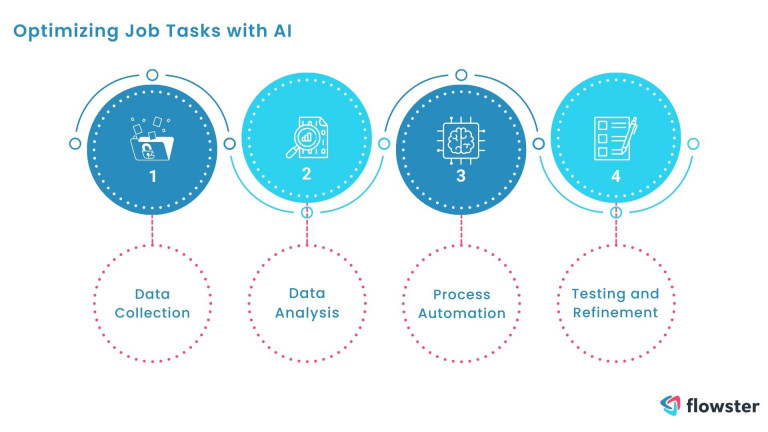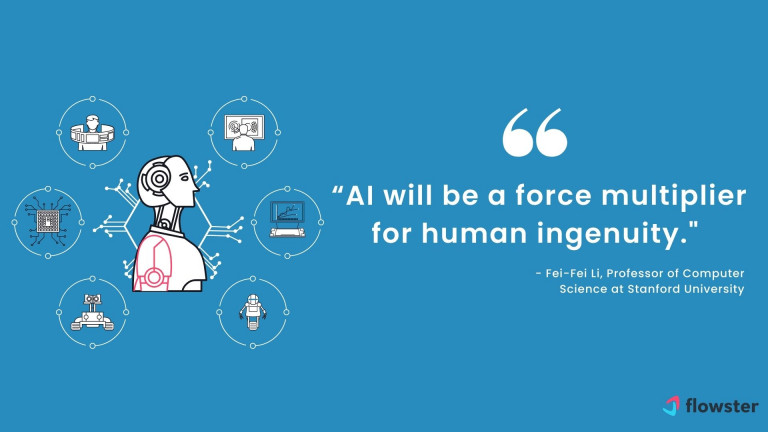In today’s fast-paced business world, companies are constantly looking for ways to improve productivity and efficiency. Job task optimization is an area that has made a lot of progress in recent years.
This is the process of using technology to automate and streamline different tasks and processes. With the rise of artificial intelligence (AI), optimizing job tasks has taken on a new dimension. Companies can now use machine learning to improve workflows and boost productivity.
This article will explore the concept of AI-powered job task optimization in depth, looking at the benefits it can offer businesses and how it works. We will also talk about common questions and worries about using AI at work and examine what this technology might mean for the future of work.
Article Outline
What is AI-Powered Job Task Optimization?
For AI-powered job task optimization, machine learning algorithms are used to analyze data and automate different tasks and processes at work. This technology can be applied to a wide range of industries and job functions, from manufacturing and logistics to customer service and marketing.
The goal of AI-powered job task optimization is to improve workflows, cut down on mistakes, and boost productivity by automating tasks that are repetitive or take a lot of time. By doing so, businesses can free up their employees’ time to focus on higher-level tasks that require human expertise and creativity.
How Does AI-Powered Job Task Optimization Work?
The process of AI-powered job task optimization typically involves several steps:

Step 1: Data collection
The first step is to collect data on the specific task or process that needs to be optimized. This data may come from a variety of sources, such as sensors, databases, or manual input from employees.
Step 2: Data Analysis
After the data has been collected, it is looked at with algorithms for machine learning to find patterns and new insights. This analysis can help find ways to improve the process, like cutting down on waste or getting rid of bottlenecks.
Step 3: Process Automation
After the analysis is complete, the next step is to automate the process using AI-powered tools and technologies. This could mean making custom software or using tools already on the market, like software for robotic process automation (RPA) or natural language processing (NLP).
Step 4: Testing and Refinement
Once the automated process is in place, it is tested and refined to ensure that it is working as intended. This may involve making adjustments to the algorithms or software to improve performance.
What Are the Benefits of AI-Powered Job Task Optimization?
The use of AI-powered job task optimization can offer several benefits for businesses, including:
Increased efficiency: By automating tasks that are repetitive or take a lot of time, businesses can be more efficient and finish some processes faster.
Reduced errors: Automation can also help reduce the likelihood of errors and mistakes, which can save businesses time and money in the long run.
Improved productivity: With AI-powered job task optimization in place, employees can focus on higher-level tasks that require human expertise and creativity, which can lead to increased productivity and innovation.
Cost savings: Automation can help cut down on labor costs and make operations more efficient, which can save businesses a lot of money over time.
Scalability: AI-powered job task optimization can be easily scaled to accommodate growth or changes in business needs without requiring significant additional resources or labor.
Transform Your Business Processes with Flowster's AI-Driven Automation
What Are Some Examples of AI-Powered Job Task Optimization?
AI-powered job task optimization can be applied to a wide range of industries and job functions. Some examples include:
Manufacturing: Machines with AI can do things like quality control, assembly, and packaging by themselves on the production line.
Logistics: AI-powered tools can improve shipping routes and delivery times, as well as automate tasks like keeping track of inventory and processing orders.
Customer service: Virtual assistants and chatbots can be used to automate customer service tasks like answering common questions and solving problems.
Marketing: AI-powered tools can help businesses analyze customer data and make personalized marketing campaigns based on each customer’s preferences and actions.
Addressing Concerns About AI in the Workplace
Despite the potential benefits of AI-powered job task optimization, some people may have concerns about the use of AI in the workplace. Here are some common questions and concerns, along with answers and explanations:
Will AI replace human workers?
AI can automate some tasks and processes, but it probably won’t be able to do everything humans do. Instead, AI can be used to augment human capabilities and make certain tasks easier and more efficient. Also, as more businesses use technologies that are powered by AI, new jobs may open up in areas like data analysis and developing AI.
Is AI biased or discriminatory?
AI algorithms can be biased if they are trained on biased data or if the programmers who developed them hold biases themselves. But these biases can be lessened by doing things like using different kinds of training data and checking algorithms regularly to make sure they are fair.
What about privacy concerns?
AI-powered tools may collect and process personal data, which can raise privacy concerns. But businesses can ease these worries by putting in place strict policies about data privacy and making sure that data is collected and used in a clear and honest way.

The Future of Work with AI-Powered Job Task Optimization
As AI-powered job task optimization continues to evolve, it has the potential to transform the way we work and do business. By automating routine tasks and processes, businesses can give their employees more time to work on higher-level tasks that require human expertise and creativity.
However, as with any new technology, it is important to proceed with caution and ensure that AI is being used in a responsible and ethical manner. By doing this, businesses can use AI to drive innovation, boost productivity, and make the workplace more effective and efficient.
AI-Powered Job Task Optimization FAQs
What is AI-powered job task optimization?
AI-powered job task optimization is when a business or organization uses artificial intelligence to automate and streamline different tasks and processes.
What are the benefits of AI-powered job task optimization?
AI-powered job task optimization has many benefits, such as increased efficiency, fewer mistakes, cost savings, the ability to grow, and the ability to give valuable insights into how customers behave and how the market is changing.
What are some examples of AI-powered job task optimization?
Examples of AI-powered job task optimization include manufacturing, logistics, customer service, and marketing.
Will AI replace human workers?
AI can automate some tasks and processes, but it probably won’t be able to do everything humans do. Instead, AI can be used to augment human capabilities and make certain tasks easier and more efficient.
What about privacy concerns with AI-powered technologies?
AI-powered tools may collect and process personal data, which can raise privacy concerns. But businesses can ease these worries by putting in place strict policies about data privacy and making sure that data is collected and used in a clear and honest way.
Conclusion
AI-powered job task optimization is a powerful tool that can help businesses automate and streamline different tasks and processes. By doing so, businesses can increase efficiency, reduce errors, and free up their employees’ time to focus on higher-level tasks.
While there may be concerns about the use of AI in the workplace, steps can be taken to mitigate these concerns and ensure that AI is being used in a responsible and ethical manner. As AI-powered job task optimization continues to evolve, it has the potential to transform the way we work and do business.
AI-powered technologies are likely to be used more in the future of work, and businesses that follow this trend are more likely to be able to compete and do well in the market.
AI-powered job task optimization can be applied across a wide range of industries and job functions, and its benefits are clear. By automating routine tasks, businesses can increase efficiency, reduce errors, and improve overall performance.
In addition, AI-powered technologies can help businesses stay competitive by providing valuable insights into customer behavior, market trends, and more.
As AI-powered job task optimization becomes more common, businesses will need to invest in the right technology, talent, and training to fully use its potential. By doing so, businesses can create a more efficient and effective workplace while also providing new opportunities for their employees to learn and grow.
Ready to Create Your First AI-Driven Automated Workflow?
Start from scratch to make an automated workflow template, or look through our templates in Flowster’s Marketplace.
Want help? Use our “Done for You” service to let our experts build custom workflows for you.
Related Articles
Would you like to learn more? See our other informative articles.
How Flowster’s New AI Feature is Supercharging Your Workflow Efficiency
What Process Management Tool Is Right For You? Flowster vs Alternatives

